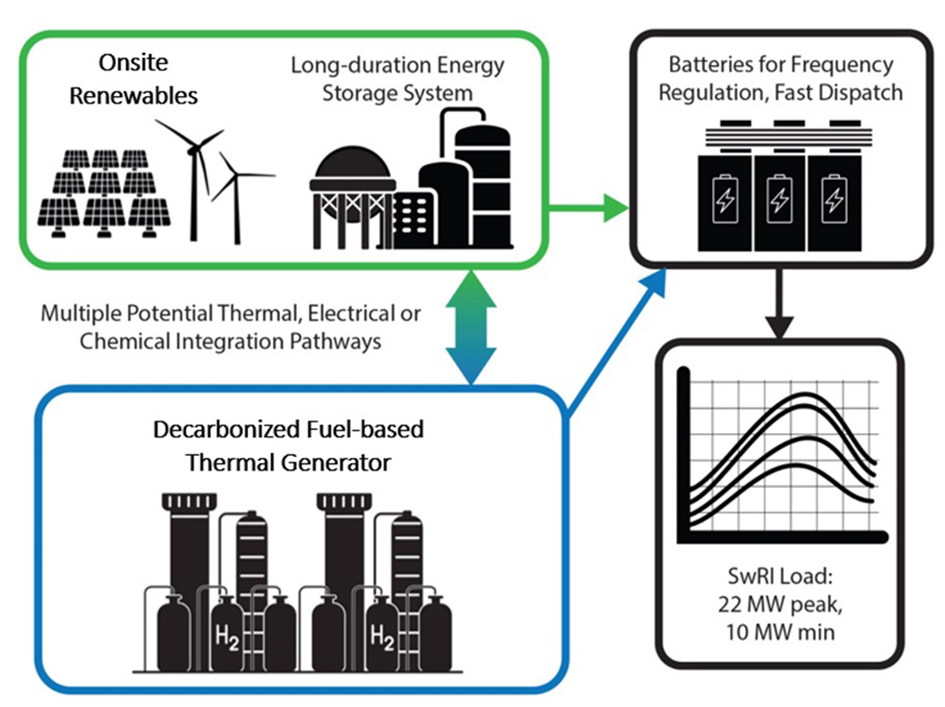Background
The recent shift in the global perspective of energy production strongly favors the development and implementation of renewable, decarbonized power. Recent executive orders from the United States government direct multiagency priority to target a carbon-pollution-free electricity sector during the next 15 years. Shifting the energy grid from the current non-renewable sources to new renewable or decarbonized non-renewable technologies presents a variety of challenges that could strain energy supplies. An initial evaluation of these technologies is being performed to identify and define pilot-scale systems that leverage commercial and government funding to create onsite net-zero cost-effective electricity production infrastructure at SwRI and to demonstrate new pilot-scale clean energy technologies for clients. A representation of the interacting decarbonized systems on SwRI’s site is shown in the figure below.
Approach
The project is investigating the SwRI campus characteristics and opportunities as a premiere location for clean energy research and pilot-scale demonstration to achieve U.S. decarbonization targets. The technical approach consisted of early feasibility study activities to evaluate SwRI’s electrical demand, site power requirements, and will document infrastructure and contractual agreements. Subsequently, the project team developed an analytical tool that evaluated onsite power generation technologies suitable for SwRI’s electricity usage, land availability, and natural gas/electric infrastructure at scales up to full-scale net-zero power generation. Estimates on the storage necessary to utilize excess renewable power were made and the trends in cost were examined, generating a roadmap for net zero emission on SwRI campus.
The analytical tool is being further developed for modeling storage characteristics, industrial heat loads, and further expanding the renewable mix on campus. Various sizes of storage were analyzed with different photovoltaic (PV) systems to assess relative cost and performance for competitive down-selection. These technologies were compared, ranked, and narrowed to a more limited set for high-fidelity analysis in phase 3. The continuation into Phase 4 began the expanding of the capability of the PyZ analytical tool. This includes analysis of wind energy as a renewable source on SwRI campus, thermal energy as an energy sink for industrial demonstrations, geothermal as an energy source, and a more detailed model of the storage systems.
Accomplishments
The Project Z team made substantial progress on the analysis capabilities of the PyZ tool and the path to zero at SwRI. Wind generation analysis was developed and performed with an assessment of SwRI campus capabilities. The team also continued to improve the tool for industrial heat applications, advanced storage modeling, and geothermal power generation. The team continued stakeholder engagement and monitored progress on the initial 10-megawatt (MW) PV installation in the southern agricultural field. Wind generation power curves, renewable resources, and techno-economic assessment were combined to show that a mix of PV and wind renewables can provide significant improvements on decarbonization with lower costs. The model with mixed renewables showed that the lowest cost electricity was PV-only until about 30 MW of PV was installed. After that point, PV increases by several megawatts while more wind is added to the generation mix to maintain low electricity costs. The team estimated that with a limit of 10 MW of wind on SwRI campus, 50% decarbonization can be achieved while minimizing costs and without the need for long duration energy storage (LDES).
Storage improves decarbonization numbers, and new LDES systems were analyzed with their renewable mix. A molten salt pumped thermal system allowed for 64% decarbonization without going above current electric costs. Other LDES systems performed well, but as systems get larger and larger, costs escalate beyond 90% decarbonization. Adding a gas turbine with carbon capture improves decarbonization to 95% at only a 1.32 cost ratio. With this mixed system, the renewables, LDES, and gas turbine systems are a feasible size for SwRI campus. Overall, the results showed potential for low-cost, net-zero power at SwRI. Work also progressed on implementing industrial thermal energy modules, geothermal power generation, and an advanced model of storage systems.

Figure 1: Interconnected systems for decarbonized power.

